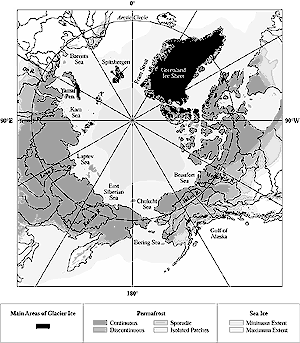16.1.2. Distinctive Characteristics of Polar Regions
|

Figure 16-1: Location map for the Arctic. Permafrost
zonation, drainage basins, sea ice, and main areas of glacier ice are
shown. Drainage basins are delimited by solid black lines. Permafrost
zonation is based on a digital version of the map by Brown et al. (1997).
|
The most distinctive feature of polar regions is the large
seasonal variation in incoming solar radiation—from very little in winter
to 24 hours of continuous sunlight in summer. Although the poles receive less
solar radiation annually than equatorial locations, near the time of the solstices
they receive more per day. The high albedo of the snow- and ice-covered polar
regions, together with the large loss of long-wave radiation through the very
clear and dry atmosphere, ensures a net loss of radiation in most months of
the year. These losses of radiation are particularly large during the long polar
night and help create a deep, stable boundary layer of very cold, dry air at
the surface.
These processes ensure sustained, very low temperatures in winter. Even in
the summer, many areas—especially in the Antarctic—remain below freezing.
Thus, much water remains frozen throughout the year. In Antarctica, snow and
ice have continued to accumulate on the continent for millions of years. On
the other hand, there are large volumes of liquid water in polar regions in
the Arctic and Southern Oceans, although their surface is partially covered
with sea ice, whose extent varies seasonally over vast areas. Sea ice insulates
the underlying water from heat loss and, because of its high albedo, reflects
much of the incoming solar radiation.
Formation of sea ice has important oceanographic consequences in that much
latent heat is released, and highly saline, dense water is created. The dense
water sinks in the north Atlantic and Southern Oceans, helping maintain the
ocean conveyor belt and carrying nutrients and carbon. Production of deep ocean
water is a consequence of processes that are operating in both polar regions.
There is little evaporation from the vast tracts of sea ice and glacier ice.
Extensive areas of the polar regions have very low precipitation; most comes
from cyclonic storms that penetrate from the surrounding belt of subpolar depressions.
The polar regions incorporate important environmental thresholds, many of which
are associated with water-phase changes. Together with the large seasonal changes
in solar radiation, polar regions stimulate important geophysical and biological
processes with high sensitivity to impacts. Sustained warming or cooling across
the freezing threshold brings dramatic physical changes over land and sea. As
a result, the physical environment, biota, and socioeconomic factors are all
vulnerable to climate change. The climate and vast areas of ice make the polar
regions very inhospitable and marginal for many species, including humans. However,
specially adapted species thrive in some terrestrial and marine polar ecosystems.
Consequently, the Arctic and Antarctic are characterized by the presence of
highly distinctive biomes and are important places for many migratory species.
Although the Antarctic continent essentially is a pristine wilderness, the great
whales and some species of seals in the Southern Ocean were commercially exploited
to virtual commercial extinction in the 19th and 20th centuries. Human activities
on many sub-Antarctic islands have altered their biota dramatically.
The Antarctic has limited resource use, apart from growing fishing and tourism
industries. There is a multinational approach to natural resources and environmental
management, with mineral exploration and exploitation banned by international
agreement. The area is managed by the Consultative Parties to the Antarctic
Treaty to the dedication of science and peace (UNEP, 1997). By contrast, the
Arctic has been populated for thousands of years. There is considerable economic
activity, based on fishing, herding, and shipping. Recent decades have seen
the establishment of urban areas and resource developments, based on the petroleum,
gas, and mining industries. The extreme environment requires unique cold-region
engineering and infrastructure solutions. There is a distinct contrast—and
sometimes conflict—between the developments of modern society and indigenous
peoples. The Arctic lies within the political boundaries of some of the world's
richest and most powerful nations. During the Cold War, it was a critical strategic
area, and substantial defense establishments remain in the region.
16.1.3. Climate Change in the 20th Century
There has been substantial climate change during the past 2 million years in
the Arctic and the Antarctic. These changes are well documented in several natural
archives, such as ice cores and marine sediments. The quasi-periodic sequence
of glacial-interglacial periods and corresponding changes in GHGs is shown clearly
in the record of atmospheric composition and climate derived from the ice cores
for the past 420,000 years (e.g.,White and Steig, 1998; Petit et al.,
1999). Longer term climate changes are not discussed in this chapter, which
focuses on observed 20th-century changes as well as those predicted for the
21st century. The following subsections provide a brief discussion of the main
climatic changes in the 20th century. More details are provided in TAR
WGI Chapter 2.
|